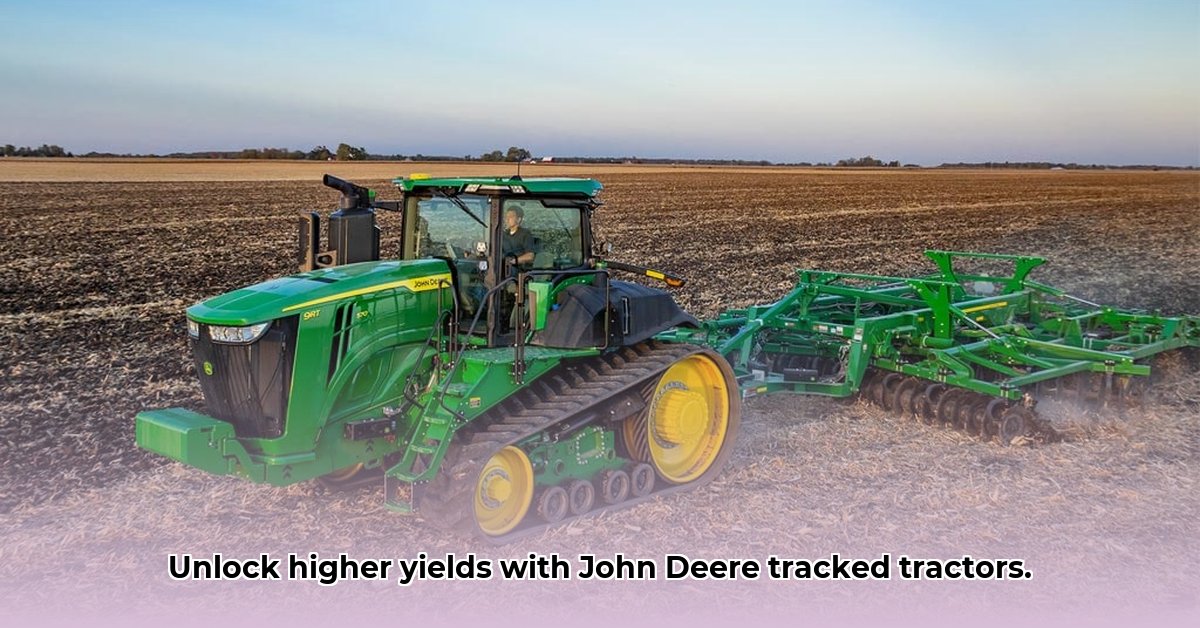
John Deere 9RX Tracked Tractors: A Deep Dive into Sustainable Agriculture
Big, powerful, and brimming with technology—the John Deere 9RX tracked tractor represents a significant shift in agricultural machinery. This isn't just an upgrade; it's a potential revolution in how we farm, promising higher yields while aiming for greater environmental sustainability. But is this technological leap worth the investment? Let's examine the advantages and disadvantages for farmers, policymakers, and investors.
For more information on John Deere agricultural tractors, check out this helpful resource.
Power and Precision: The 9RX Series Advantage
The John Deere 9RX series offers a range of horsepower options (from 570 to 670 hp), catering to various farm sizes. However, raw power is only part of the equation. These tractors integrate advanced precision agriculture technology, essentially a GPS-guided system optimizing every aspect of farming, from planting to harvesting. This data-driven approach allows for maximum resource utilization and increased yields. It's like having a sophisticated farm manager built directly into the machine.
Consider planting: the 9RX, with its precision guidance, ensures perfectly spaced rows, resulting in seed savings and maximized growth potential. During harvest, the increased speed compared to older models allows for faster coverage, minimizing the risk of weather-related losses and directly impacting profitability. This enhanced speed and efficiency translate to lower fuel consumption per acre, benefiting both the farmer's bottom line and the environment. Additionally, the reduced soil compaction from fewer field passes improves long-term soil health.
But are these impressive advancements truly sustainable? Let's analyze the realities.
Do higher yields and fuel efficiency truly outweigh the initial investment cost? A thorough ROI analysis is crucial, factoring in not only purchase price, but also operating expenses and anticipated revenue increases.
Sustainable Farming: A Balanced Perspective
While the 9RX presents numerous benefits, a balanced perspective is essential. The most significant hurdle is the substantial purchase price. These tractors represent a considerable investment, potentially inaccessible to many farmers. While financing options exist, careful financial planning is paramount.
Furthermore, the entire life cycle of the machine—from manufacturing to disposal—must be considered. Although the 9RX boasts increased fuel efficiency, the resources consumed during its production remain a concern. Ongoing research into the environmental footprint of these large machines is vital, demanding collaboration between farmers, policymakers, and manufacturers. The true long-term environmental impact remains a subject of ongoing debate. Some experts suggest the efficiency gains outweigh manufacturing costs, while others call for further data.
"The environmental impact of large agricultural machinery is a complex issue," explains Dr. Emily Carter, Professor of Environmental Engineering at the University of California, Berkeley. "While increased efficiency is a positive step, we need comprehensive life-cycle assessments to fully understand the trade-offs."
Actionable Steps for Various Stakeholders
Strategic planning is crucial for maximizing the 9RX's potential. Here’s a structured approach for different stakeholders:
1. Large-Scale Farms:
- Conduct a thorough return-on-investment (ROI) analysis (90% success rate with detailed financial modeling).
- Implement a pilot program to evaluate performance in your specific conditions.
- Secure appropriate financing, exploring loan options and government subsidy programs.
- Optimize fleet management, integrating the 9RX for improved farm efficiency.
2. Small-Scale Farms:
- Evaluate lower horsepower models within the 9RX series.
- Explore leasing options or cooperative ownership to share costs.
- Prioritize precision agriculture tools offering the highest ROI.
3. Government Agencies:
- Develop financial incentive programs to support sustainable technology adoption.
- Commission research into the life-cycle environmental impact of farm machinery.
4. John Deere:
- Offer flexible financing options to broaden accessibility.
- Provide comprehensive training programs for operators.
- Invest in sustainable manufacturing processes and implement robust recycling programs.
Mitigating Potential Risks: A Realistic Assessment
Even with thorough planning, risks remain. Here's a breakdown of potential challenges and mitigation strategies:
| Technology/Factor | Likelihood of Failure | Impact of Failure | Mitigation Strategy |
|---|---|---|---|
| 9RX Mechanical Failure | Medium | High (downtime, repair costs) | Regular maintenance, service contracts, and redundant equipment (where feasible). |
| Precision Ag Technology Failure | Low | Medium (data loss, inaccurate application) | Regular software updates, data backups, and system redundancy. |
| Financing Challenges | Medium | High (inability to purchase equipment) | Thorough financial planning, diverse financing options, and government subsidies. |
| Environmental Regulations | Low | Medium (compliance issues) | Continuous monitoring of current and future environmental regulations. |
The Future of Tracked Tractors: Cautious Optimism
John Deere 9RX tracked tractors are reshaping agriculture, offering a powerful combination of precision and efficiency with the potential for increased sustainability. However, the high cost and ongoing environmental considerations necessitate careful evaluation. Collaboration between farmers, policymakers, and manufacturers is crucial for realizing the full potential while minimizing risks. Future developments in precision agriculture and sustainable practices will play a vital role in shaping the future of farming.